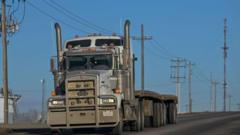In the ever-evolving world of transportation, the trucking industry is navigating a complex relationship with technology. Jared, a Canadian truck driver with over 20 years of experience, now finds himself not only hauling country music equipment but also utilizing multiple digital devices to secure gigs from the comfort of his vehicle. The era of reliance on payphones and pagers is left behind as drivers like Jared navigate a terrain where platforms reminiscent of ride-hailing services match them with freight opportunities.
The advent of these "Uberised" digital platforms has indeed simplified securing loads, but Jared notes a troubling trend—wages for long-distance hauls have plummeted, with average compensation dropping from $3 to $1.10 per mile since the pandemic. This wage decline compounds existing concerns over rising fuel costs and economic sustainability for drivers who often support themselves through fragmented employment within a primarily small-scale industry.
In Canada, where more than 80% of trucking businesses employ fewer than five individuals, unions like Teamsters Canada express serious apprehensions regarding the impact of gig work on trucking livelihoods. Christopher Monette from Teamsters highlights that stagnant wages over the last 25 years are exacerbated by gig-style employment's growth, which threatens the operational integrity of established carriers that uphold safety and training standards.
While Uber Freight claims to offer flexibility, transparency, and a choice for carriers to negotiate their rates, advocates argue for stronger protections for drivers rather than further digital integration. For instance, Vancouver-based Freightera operates differently by enabling carriers to set their prices based on operational needs, thereby encouraging a healthier freight marketplace.
Moreover, the digitization of trucking services is a global phenomenon, with initiatives like Kenya's LORI platform managing over 20,000 trucks digitally. Such innovations assure that trucks are utilized efficiently, potentially leading to reduced empty runs and fuel consumption, which could beneficially impact carbon emissions—a pressing concern in the industry.
However, the rise of technology continues to evoke fears of automation replacing human drivers. The introduction of driverless trucks in testing phases in the U.S. and China raises questions about the long-term viability of the truck-driving profession. Despite technological advancements, many in the field, including Jared, remain skeptical about the immediacy of automation, asserting that human touch is indispensable to the industry’s foundational ethos.
With the trucking landscape changing rapidly, the balance between leveraging technology for efficiency and protecting the livelihoods of workers remains a critical debate. As Jared notes, while the tools have transformed, the heart of transportation—a connection, after all, is still vital in the world of trucking.




















